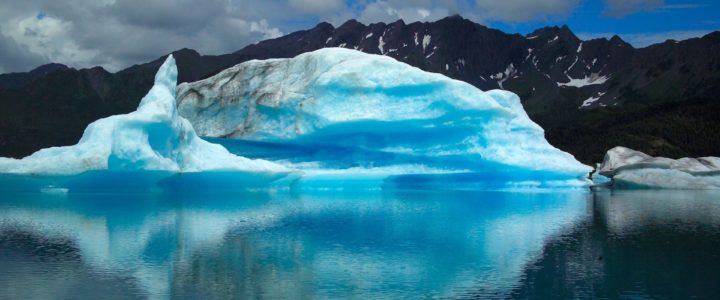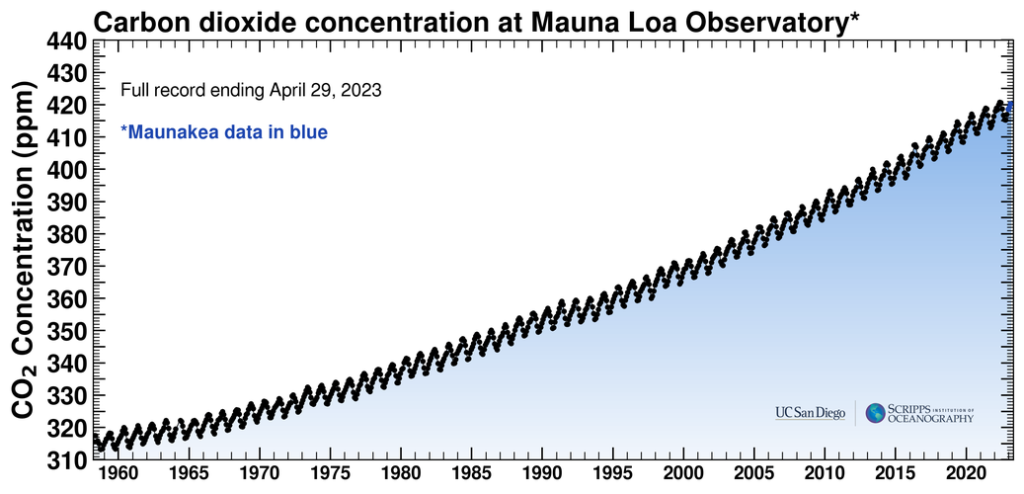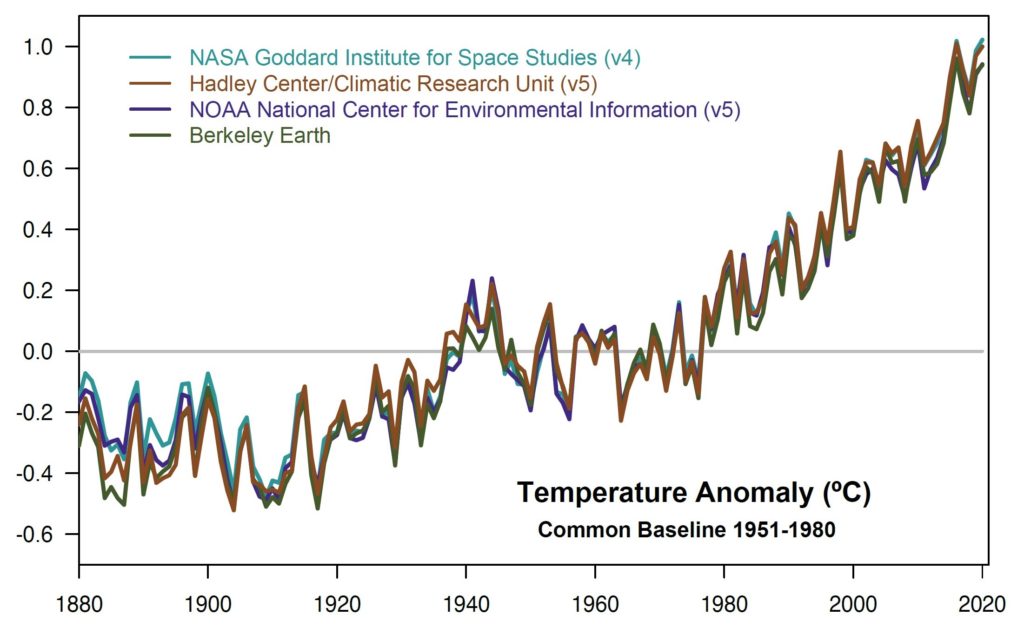
Climate science is not new. In fact, it’s been around for hundreds of years! Let’s do some time travel and explore the comprehensive history of climate science. Let’s see what climate science theories hold up, 250+ years later.
In 1754 a chap named Joseph Black discovered how to isolate carbon dioxide. Although CO2 had been discovered about 100 years prior, Black was able to identify and describe its properties. He was studying medicine in Glasgow, and using lime water found that “fixed air”, what was later to be called carbon dioxide, was released from a wide variety of things: mineral water, fermenting yeast, cremating corpses, human exhalation and burning coal and oil. Fixed air was more dense than air, would not support animal life or flame, and would turn the clear lime water milky when it was exposed to it. This not only started the ensuing work on all respiratory gases, but contributed to the foundations of modern chemistry. Black was then also pivotal in the early science of thermodynamics, introducing the concepts of latent heat and heat capacity. He worked with his friend James Watt on refining the early steam engine, essentially ushering in the Industrial Revolution.
Fast forward more than 70 years to the 19th century, and scientists had already begun to find evidence of cyclic changes in the climate over long periods of time. In 1824, Joseph Fourier recognized that our atmosphere kept the planet warmer than it otherwise would be in a vacuum. He measured temperature changes between day and night and summer and winter and measured how deep under the ground temperatures fluctuated. He postulated that all heat on Earth came from either the sun, the Earth’s core or background heat from space. He knew that when the sun created heat on Earth, there must be something else to consider, otherwise once night time came the heat would leave as quickly as it arrived – which was not the case. This led to him identifying “dark rays”, or “radiant heat”, differentiating this from light heat or visible light. We now call this infrared radiation. His theory was that the energy from the sun arrives in visible light, passing through the atmosphere easily and heating the Earth. The Earth then gives off dark heat, which doesn’t pass through the atmosphere as readily. So that is, shortwave visible light energy comes from the sun, while long wave infrared rays are bounced back into the atmosphere. But – the atmosphere traps some of the infra-red rays trying to leave the Earth’s surface. It wasn’t clear why.

Until 1856. Eunice Newton Foote, who was a woman’s rights activist and amateur scientist, examined the warming effect of the sun on our planet, and learned that this increased with the presence of carbon dioxide. Her paper described the first recorded experiment proving the greenhouse gas effect! That is, certain gases hold onto the long wave infrared light which is reflected back to space from the Earth’s surface.
In 1859, John Tyndall also conducted experiments, with the same results. He linked hydrocarbons (such as methane and carbon dioxide, which was then called carbonic-acid-gas) with the absorption of infrared radiation and found them to strongly block the radiation. There has been conjecture around whether Tyndall stole from Foote’s work, and merely applied a more professional scientific approach, being that he was in fact a scientist. But Tyndall was in Ireland and Eunice Foot was in New York. So the likelihood of him having seen her work, which was not widely spoken about, is minimal. Although he was the editor of the British publication called Philosophical Magazine at the time when they republished a paper he first saw in the the American Journal of Science and Arts…which appeared opposite Eunice Foot’s paper. Tyndall was known to disapprove of women in science, like the vast majority of his colleagues, so he may not have stolen the work, but we can be confident that he also wouldn’t have held it up for accolades. Anyway, moving on! The key takeaway is that both people had proven that the presence of carbon dioxide increased the absorption of the sun’s radiative energy, thus warming the atmosphere.
Swedish chemist, Svante Arrhenius, was the first to quantify what the effect was of the presence of carbon dioxide in the atmosphere on the Earth’s surface temperature. In 1896 he published a paper with his first estimations on man-made global temperature change. Interestingly, rather than being concerned, he speculated that the warming could possibly be beneficial for future generations, who’d be met with “ a milder sky and less barren surroundings”.
A few years later though, in 1899, Thomas Chrowder Chamberlin wrote a book “An Attempt to Frame a Working Hypothesis of the Cause of Glacial Periods on an Atmospheric Basis” that discussed the idea that changes in atmospheric carbon dioxide will result in changes to the climate. He did not share Arrhenius’ optimism. Instead, all the way back in 1899, he identified the need to remove excess carbon dioxide from the atmosphere! He echoed Newton Foote’s concern, that too much CO2 would create too much warming.
At the start of the 20th century, several scientists and engineers continued to present evidence which supported the greenhouse effect theories. One was amateur scientist and steam technologist Guy Callendar. In 1938 he collected data from 200 weather stations across the globe. He was able to prove that global temperature had risen 0.25 degrees Celsius in 50 years, and he argued that this was due to the increasing collection of carbon dioxide in the atmosphere, which he further alleged was from the burning of fossil fuels. This was dubbed the Callendar Effect. But again, like Arrhenius, Callendar felt this was a good thing. He stated that the continued burning of fossil fuels would benefit humankind greatly, beyond heating and electricity, as it would save the planet from going through another deadly glacial period.
However, by the 1950’s, there began to be increasing concern for the potential of man-made climate change. In 1958 Charles Keeling started measuring atmospheric CO2 from the Mauna Loa weather station in Hawaii. He was meticulous and within 5 years of daily measurements found unequivocally that the CO2 in the atmosphere had risen significantly. Even more importantly, he was able to analyze the samples of CO2 to determine that the rise was due to burning fossil fuels. The measurements still continue daily at this site and the resulting graph is known as the Keeling Curve.

The Nimbus satellites were launched in 1964, and would revolutionize our study on weather, climate and the atmosphere. They collected data on global temperatures, the concentration of greenhouse gases in the atmosphere, the ozone layer, as well as sea ice thickness. This also allowed scientists to develop computer models that could forecast weather a week, or even two weeks, in advance, something previously impossible. In 1969 instruments were added to the Nimbus III which would enable measurement of atmospheric temperature – this showed an independent satellite record of rising temperatures in the lower atmosphere.
Finally by the 1980’s, a consensus began to form as the scientific community rallied around Climate Science. In 1985 a team of French and former Soviet scientists extracted an Antarctic ice core over 2,000 meters long – so they could determine atmospheric conditions 150,000 years ago. But then in 1998 the team went deeper, extending the records they could produce to 450,000 years ago. Both of these ice cores show a clear relationship between atmospheric CO2 and Antarctic temperatures.
In 2004, this was bettered yet again, with an ice core over 3km in length being extracted, giving us insight to the atmosphere and climate 800,000 years ago. Even taking into account the slight fluctuations which show the close relationship between CO2 and temperature, all three ice cores prove that until the 19th century, atmospheric CO2 was largely stable. It has been since then that we’ve seen a rapid rise, incomparable to anything prior. The fastest move out of an ice age saw a 35 parts per million increase in CO2 over 1,000 years. Compared with us seeing this same rise in atmospheric CO2 over only the last 17 years!
NASA has compared temperature anomalies from various reputable sources and shown an undeniable increasing trend over the last 140 years. Even if you look at this graph upside down, the indisputable trend in global average temperatures is upwards.

Since the 80’s we’ve been witness to more and more scientists showing concern for the effects of human-made, or anthropogenic, climate change. Scientists have reached a consensus.
Even those who deny, or don’t understand, the climate science cannot deny that our resources will eventually run out, nor the pollution that is caused from fossil fuels. So why would we wait to transition to a sustainable future? There really doesn’t seem to be a downside to implementing lifestyle and system choices which would reduce pollution, protect biodiversity, and enable a more equitable, comfortable and peaceful future on this incredible planet!


